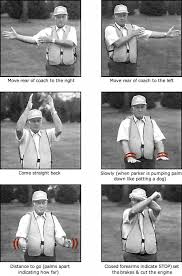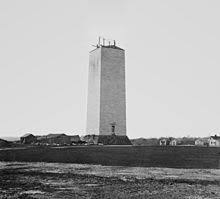For “tRaVersing Thursday”, or RV Day:
“Vision Tips:

a) Use extra caution when turning left and trying to judge the speed/distance of oncoming vehicles.
b) Drive more slowly at night and avoid looking directly into headlights of approaching vehicles; look slightly to the right.
c) Reduce driving at night, dusk or dawn when visibility is more difficult.
d) Have regular eye examinations, also ask if you should get separate glasses for day and night driving.
RV Related tips
1) Braking is different for an RV. If you are towing,then your trailer might have brakes that are wired into your vehicle's braking system. Don't ride the brakes on your motor home or trailer, because they could get hot and stop working. Moderate your speed to prepare for braking, decelerate before an off ramp and keep your brakes in good condition. 
But you must also stay in your own lane to avoid a collision, so simply pull out farther into the intersection before starting the turn. Take some time to practice turning with your RV before you head out on a road trip.
3) Your RV is higher than a car or pickup truck. Some of the routes you are familiar with could be inappropriate for your RV. To avoid getting stuck below a railroad bridge or damaging your RV by hitting an overpass, know your height and the maximum allowed by tunnels, bridges, parking garages, and overpasses. A road atlas designed specifically for RV drivers or truck drivers will list the routes you can't drive on.
Some basic towing tips
a) Connect brakes and signal lights. Always check that the trailer's brakes, turn signals, and taillights are synchronized with those of the tow vehicle. ![images[7] images[7]](https://blogger.googleusercontent.com/img/b/R29vZ2xl/AVvXsEi_AY89bkUYz5kGrSt5TlBGu0gXXFRxDpKWTfSxSujAxMFnTuU2P9i2ILqjefh1u7PcAb6KmbDD88_77ca2j1CUnxkSghojgM2BrJe-2VgwPu7ymW_iedyTK-L-ZNB9bzwDX4PBdDIs3KTk/?imgmax=800)
c) Once the trailer is moving in the proper direction, avoid any sharp movements of the steering wheel. Slowly steer the vehicle into its desired direction. It is also a good idea to have someone outside the vehicle assist the driver in backing up to avoid any obstacles not seen in the mirrors.
If another person is not available, the driver should inspect the area behind the vehicle first. By evaluating the situation before backing, drivers
can avoid surprises and accidents.
Some basic Fog or Dust Storm tips

b) Keep low beam headlights on to help others see you.
c) Chain-reaction accidents are common. If visibility becomes poor, pull off to a safe place, and wait for conditions to improve. DO NOT creep at 5 to 10 miles per hour.
d) Check your speedometer often. Without visual cues, there is a tendency to increase speed.
Big rig tips

b) Front "No- Zone"-Pass Safely. Don't cut in front too soon after passing a truck, bus or a rig. The large vehicle needs more time and room to
adjust than a car.
c) Look for the whole front of the large vehicle in your mirror before pulling in front.
d) Remember when driving a big rig they have a much bigger blind spots.
Large travel trailer tips

set some props for turning and backing practices.
2) Make sure to check the routes before driving off for a trip especially restrictions imposed on bridges and tunnels.
3) Avoid any sudden stops and starts as much as possible. This will result to skidding, sliding and jack knifing.
4) Restrain from sudden steering maneuvers that might cause swaying or excessive side force on your travel trailer.
5) Refrain from parking on grades as much as possible. Ask someone to guide when parking. Make sure that blocks are placed on the downhill side on your trailer wheels before shifting into Park, set the parking brake, carefully ease off the foot brake to allow all slack to be taken up, then change into Park before taking off your foot from the brake pedal. This sequence in parking is very crucial to ensure that your vehicle is not locked in Park because of the excess load on the transmission.
6) Uncoupling your fifth wheel travel trailer, the blocks must be put at the front and rear ends of the trailer. This is to make sure that your trailer does not roll away once the trailer hitch is released.
7) Before uncoupling your travel trailer, jack stands should be placed under the trailer to avoid any injury that may be caused by sudden rotating because of unbalanced loads.
Motorhome Driving Tips
1) Backing Up / Parking. Backing up with a motorhome is one of the most common reasons for collision and accidents. That is why it should be done very carefully. Because of the length of the motorhome, it is rather difficult to see the whole coach. Rear and side mirrors are not always very helpful to indicate the situation behind you. So- Never back up without someone to assist you. Ask one of the other passengers to get
out of the vehicle and guide you from the outside. Leave enough room in
front of your motorhome incase you need to drive forward, especially if you are towing another vehicle. Backing up while parking in a campground also requires guidance and direction, because the driver
can’t always see what’s behind.
2) Stopping. Since the motor home is a heavy large vehicle, it takes it more time to slow down or accelerate. Avoid sudden stopping by changing gears gently and graduate. Slow down when entering busy
traffic, and make sure you have enough time to stop.
3) Breaks. Don’t drive while you are tired. Take a break every two hours in a rest area, for refreshment and rest. Walk around a little to keep your blood flowing. It is recommended not to drive more than 5 hours a day.”
________
On This Day:
Washington Monument completed, Dec 6, 1884:
“On this day in 1884, in Washington, D.C., workers place a nine-inch aluminum pyramid atop a tower of white marble, completing the construction of an impressive monument to the city's namesake and the nation's first president, George Washington. As early as 1783, the infant U.S. Congress decided that a statue of George Washington, the great Revolutionary War general, should be placed near the site of the new Congressional building, wherever it might be. After then-President Washington asked him to lay out a new federal capital on the Potomac River in 1791, architect Pierre L'Enfant left a place for the statue at the western end of the sweeping National Mall (near the monument's present location).
It wasn't until 1832, however--33 years after Washington's death--that anyone really did anything about the monument. That year, a private Washington National Monument Society was formed. After holding a design competition and choosing an elaborate Greek temple-like design by architect Robert Mills, the society began a fundraising drive to raise money for the statue's construction. These efforts--including appeals to the nation's schoolchildren--raised some $230,000, far short of the $1 million needed. Construction began anyway, on July 4, 1848, as representatives of the society laid the cornerstone of the monument: a 24,500-pound block of pure white marble.
Six years later, with funds running low, construction was halted. Around the time the Civil War began in 1861, author Mark Twain described the unfinished monument as looking like a "hollow, oversized chimney." No further progress was made until 1876--the centennial of American independence--when President Ulysses S. Grant authorized construction to be completed.
Made of some 36,000 blocks of marble and granite stacked 555 feet in the air, the monument was the tallest structure in the world at the time of its completion in December 1884. In the six months following the dedication ceremony, over 10,000 people climbed the nearly 900 steps to the top of the Washington Monument. Today, an elevator makes the trip far easier, and more than 800,000 people visit the monument each year. A city law passed in 1910 restricted the height of new buildings to ensure that the monument will remain the tallest structure in Washington, D.C.--a fitting tribute to the man known as the "Father of His Country."
________
Yesterday:
The bill for the TV cable and Internet went up again. I couldn’t believe it. And I couldn’t believe how complicated it was to change. I spent most of the day talking to different satellite companies. Just as I had agreed to go with one, had the credit check, made the installation appointment, I found out that the plan didn’t offer the TV channel that is one of our favourites. It was in a much more expensive plan. Back to square one.
So I checked with another company, and it was in their cheapest package and they offered more free boxes. Of course, sometimes the call would be dropped and I had to start all over again with a different representative. Then they would have to transfer me to the agent that arranges for the Internet connection, and make the agreement for that. So back to the first company and cancel everything.
Finally, we will have all the channels we want, (I hope)faster Internet, (they said), and it will be cheaper than the cable. I know I won’t like the great big complicated remotes, I just got used to the little ones.
I didn’t have time to do the original “RV Day” post, as apart from tending to the critters, that TV/Internet project was all I got done yesterday.



















No comments:
Post a Comment